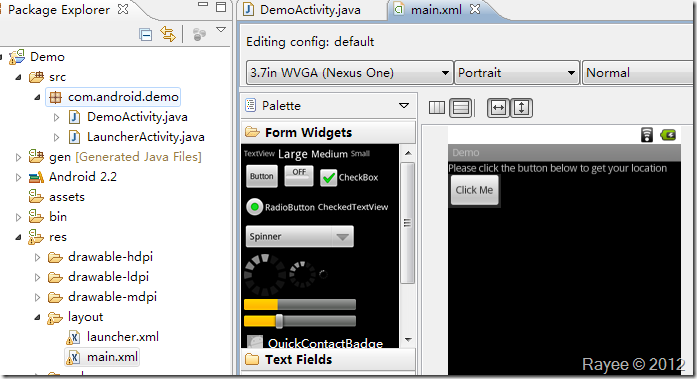经过前面几节的学习,我们已经对Android程序的开发流程有了个大体的了解,为了提高我们的学习兴趣,在这一节我们将编写一个简单的基站定位程序。现在LBS(Location Based Service,基于位置的服务)移动应用相当流行(如:微信,切客,嘀咕,街旁等),基站定位是这类程序用到的关键性技术之一,我们来揭开它的神秘面纱吧。
在这一节里,我们会接触到事件、TelephonyManager、HTTP通信、JSON的使用等知识点。
声明
本系列文章不是教程,仅为笔记,如有不当之处请指正。
欢迎转载,转载请保留原出处:http://www.cnblogs.com/rayee
目录
一、设置界面
二、为按钮绑定事件
三、获取基站信息
四、获取经纬度
五、获取物理位置
六、显示结果
七、运行程序
八、总结
九、程序代码
正文
在Android操作系统下,基站定位其实很简单,先说一下实现流程:
调用SDK中的API(TelephonyManager)获得MCC、MNC、LAC、CID等信息,然后通过google的API获得所在位置的经纬度,最后再通过google map的API获得实际的地理位置。(google真牛!)
有同学会问:MNC、MCC、LAC、CID都是些什么东西?google又怎么通过这些东西就获得经纬度了呢?
我们一起来学习一下:
MCC,Mobile Country Code,移动国家代码(中国的为460);
MNC,Mobile Network Code,移动网络号码(中国移动为00,中国联通为01);
LAC,Location Area Code,位置区域码;
CID,Cell Identity,基站编号,是个16位的数据(范围是0到65535)。
了解了这几个名词的意思,相信有些朋友已经知道后面的事了:google存储了这些信息,直接查询就能得到经纬度了。(至于google怎么得到移动、联通的基站信息,这就不得而知了,反正google免费提供接口,直接调用就是)
下面开始动手。
一、设置界面
我们在上一节的程序的基础上进行开发,在DemoActivity的界面上实现这个功能。(没有代码的同学可点击这里下载,感谢yuejianjun同学的建议,以后我会在每一节的最后把例子打包提供下载)
首先我们将DemoActivity使用的布局修改一下:

第1行为TextView,显示提示文字;第2行为一个Button,触发事件;第3行、第4行分别显示基站信息和地理位置(现在为空,看不到)。
layout/main.xml文件内容如下:
|
1
2
3
4
5
6
7
8
9
10
11
12
13
14
15
16
17
18
19
20
21
22
23
24
25
26
27
28
29
30
|
<?xmlversion="1.0"encoding="utf-8"?>android:layout_width="fill_parent"android:layout_height="fill_parent"android:orientation="vertical"> <TextViewandroid:layout_width="fill_parent"android:layout_height="wrap_content"android:text="Please click the button below to get your location"/> <Buttonandroid:id="@+id/button1"android:layout_width="wrap_content"android:layout_height="wrap_content"android:text="Click Me"/> <TextViewandroid:id="@+id/cellText"android:layout_width="wrap_content"android:layout_height="wrap_content"android:text=""/> <TextViewandroid:id="@+id/lacationText"android:layout_width="wrap_content"android:layout_height="wrap_content"android:text=""/> </LinearLayout> |
接下来我们打开DemoActivity.java编写代码。
二、为按钮绑定事件
我们在Activity创建时绑定事件,将以下代码添加到setContentView(R.layout.main);后:
|
1
2
3
4
5
6
7
8
9
10
|
/** 为按钮绑定事件 */Button btnGetLocation = (Button)findViewById(R.id.button1);btnGetLocation.setOnClickListener(newOnClickListener() { @Overridepublicvoid onClick(View arg0) {// TODO Auto-generated method stubonBtnClick();}}); |
同时还需要在头部import相关组件:
|
1
2
3
|
import import import |
我们来分析一下这段代码:
首先我们通过findViewById(R.id.button1)找到按钮这个对象,前面加(Button)表示显示的转换为Button对象;
然后设置按钮点击事件的监听器,参数为OnClickListener对象,再重载这个类的onClick方法,调用onBtnClick方法(这个方法得由我们自己去写,他在点击按钮时被调用)。
好了,调用方法写好了,我们来写实现(调用后需要做什么事)。动手编码之前先在脑中整理好思路,养成好习惯。
我们需要在DemoActivty类中添加如下私有方法:
- 我们需要刚刚提到的onBtnClick回调方法,被调用时实现取得基站信息、获取经纬度、获取地理位置、显示的功能。但是很显然,全部揉到一个方法里面并不是个好主意,我们将它分割为几个方法;
- 添加获取基站信息的方法getCellInfo,返回基站信息;
- 添加获取经纬度的方法getItude,传入基站信息,返回经纬度;
- 添加获取地理位置的方法getLocation,传入经纬度,返回地理位置;
- 添加显示结果的方法showResult,传入得到的信息在界面上显示出来。
好了,先将方法添上,完整代码如下:
|
1
2
3
4
5
6
7
8
9
10
11
12
13
14
15
16
17
18
19
20
21
22
23
24
25
26
27
28
29
30
31
32
33
34
35
36
37
38
39
40
41
42
43
44
45
46
47
48
49
50
51
52
53
54
55
56
57
58
59
60
61
62
63
64
65
66
67
|
package import import import import import import import public DemoActivity extendsActivity { /** Called when the activity is first created. */@Overridepublicvoid onCreate(Bundle savedInstanceState) {super.onCreate(savedInstanceState);setContentView(R.layout.main);/** 为按钮绑定事件 */Button btnGetLocation = (Button)findViewById(R.id.button1);btnGetLocation.setOnClickListener(newOnClickListener() { @Overridepublicvoid onClick(View arg0) {// TODO Auto-generated method stubonBtnClick();}});}/** 基站信息结构体 */publicclass SCell{ publicint MCC; publicint MNC; publicint LAC; publicint CID; }/** 经纬度信息结构体 */publicclass SItude{ publicString latitude; publicString longitude; }/** 按钮点击回调函数 */privatevoid onBtnClick(){
}/** 获取基站信息 */privateSCell getCellInfo(){ }/** 获取经纬度 */privateSItude getItude(SCell cell){ }/** 获取地理位置 */privateString getLocation(SItude itude){ }/** 显示结果 */privatevoid showResult(SCell cell, String location){}} |
现在在onBtnClick方法中编码,依次调用后面几个方法,代码如下:
|
1
2
3
4
5
6
7
8
9
10
11
12
13
14
15
16
17
18
19
20
21
22
23
24
25
26
27
28
29
30
31
|
/** 按钮点击回调函数 */private onBtnClick(){ /** 弹出一个等待状态的框 */ProgressDialog mProgressDialog =new ProgressDialog(this);mProgressDialog.setMessage("正在获取中...");mProgressDialog.setProgressStyle(ProgressDialog.STYLE_SPINNER);mProgressDialog.show();try{ /** 获取基站数据 */SCell cell = getCellInfo();/** 根据基站数据获取经纬度 */SItude itude = getItude(cell);/** 获取地理位置 */String location = getLocation(itude);/** 显示结果 */showResult(cell, location);/** 关闭对话框 */mProgressDialog.dismiss();}catch(Exception e) { /** 关闭对话框 */mProgressDialog.dismiss();/** 显示错误 */TextView cellText = (TextView)findViewById(R.id.cellText);cellText.setText(e.getMessage());}} |
按钮相关的工作就完成了,接下来编写获取基站信息的方法。
三、获取基站信息
获取基站信息我们需要调用SDK提供的API中的TelephonyManager,需要在文件头部引入:
|
1
2
|
import import |
完整代码为:
|
1
2
3
4
5
6
7
8
9
10
11
12
13
14
15
16
17
18
19
20
21
22
23
24
25
26
27
28
|
/**
* 获取基站信息** @throws Exception*/private throws SCell cell =new SCell();
/** 调用API获取基站信息 */TelephonyManager mTelNet = (TelephonyManager) getSystemService(Context.TELEPHONY_SERVICE);GsmCellLocation location = (GsmCellLocation) mTelNet.getCellLocation();if(location == null)thrownew Exception("获取基站信息失败");String operator = mTelNet.getNetworkOperator();intmcc = Integer.parseInt(operator.substring(0,3)); intmnc = Integer.parseInt(operator.substring(3));intcid = location.getCid(); intlac = location.getLac(); /** 将获得的数据放到结构体中 */cell.MCC = mcc;cell.MNC = mnc;cell.LAC = lac;cell.CID = cid;returncell; } |
如果获得的位置信息为null将抛出错误,不再继续执行。最后将获取的基站信息封装为结构体返回。
四、获取经纬度
在这一步,我们需要采用HTTP调用google的API以获取基站所在的经纬度。
Android作为一款互联网手机,联网的功能必不可少。Android提供了多个接口供我们使用,这里我们使用DefaultHttpClient。
完整的方法代码如下:
|
1
2
3
4
5
6
7
8
9
10
11
12
13
14
15
16
17
18
19
20
21
22
23
24
25
26
27
28
29
30
31
32
33
34
35
36
37
38
39
40
41
42
43
44
45
46
47
48
49
50
51
52
53
54
55
56
57
58
59
60
61
62
63
64
|
/**
* 获取经纬度** @throws Exception*/private throws SItude itude =new SItude();
/** 采用Android默认的HttpClient */HttpClient client =new DefaultHttpClient();/** 采用POST方法 */try{ /** 构造POST的JSON数据 */JSONObject holder =new JSONObject();holder.put("version","1.1.0");
holder.put("host","maps.google.com");holder.put("address_language","zh_CN");
holder.put("request_address",true); holder.put("radio_type","gsm"); holder.put("carrier","HTC"); JSONObject tower =new JSONObject();tower.put("mobile_country_code", cell.MCC);tower.put("mobile_network_code", cell.MNC);tower.put("cell_id", cell.CID);tower.put("location_area_code", cell.LAC);JSONArray towerarray =new JSONArray();towerarray.put(tower);holder.put("cell_towers", towerarray);StringEntity query =new StringEntity(holder.toString());post.setEntity(query);/** 发出POST数据并获取返回数据 */HttpResponse response = client.execute(post);HttpEntity entity = response.getEntity();BufferedReader buffReader =new BufferedReader(newInputStreamReader(entity.getContent())); StringBuffer strBuff =new StringBuffer();String result =null; while((result = buffReader.readLine()) != null) {strBuff.append(result);}/** 解析返回的JSON数据获得经纬度 */JSONObject json =new JSONObject(strBuff.toString());JSONObject subjosn =new JSONObject(json.getString("location"));itude.latitude = subjosn.getString("latitude");itude.longitude = subjosn.getString("longitude");Log.i("Itude", itude.latitude + itude.longitude);}catch (Exception e) {Log.e(e.getMessage(), e.toString());thrownew Exception("获取经纬度出现错误:"+e.getMessage());}finally{
post.abort();client =null; }returnitude; } |
代笔中关键的地方都作了注释,同学们还有不理解的举手哈。
在这里采用POST方法将JSON数据发送到googleAPI,google返回JSON数据,我们得到数据后解析,得到经纬度信息。
关于google 基站信息API的官方说明>>请到这里查看。
五、获取物理位置
得到经纬度后,我们将之转换为物理地址。
我们仍然使用DefaultHttpClient来调用google地图的API,获得物理信息,不过在这里我们使用GET方法。
完整的方法代码如下:
|
1
2
3
4
5
6
7
8
9
10
11
12
13
14
15
16
17
18
19
20
21
22
23
24
25
26
27
28
29
30
31
32
33
34
35
36
37
38
39
40
41
42
43
44
45
46
|
/**
* 获取地理位置** @throws Exception*/private throws String resultString =""; /** 这里采用get方法,直接将参数加到URL上 */String urlString = String.format("http://maps.google.cn/maps/geo?key=abcdefg&q=%s,%s",Log.i("URL", urlString);/** 新建HttpClient */HttpClient client =new DefaultHttpClient();/** 采用GET方法 */HttpGet get =new HttpGet(urlString);<
|